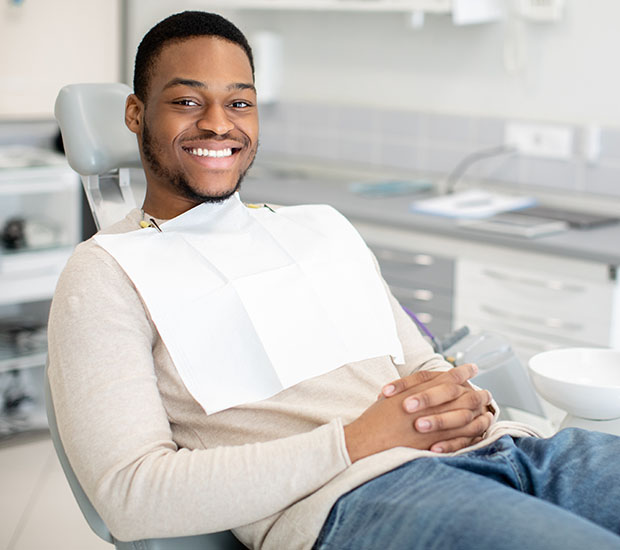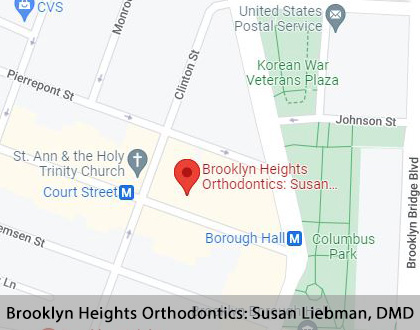OrthodontistBrooklyn, NY
An orthodontist can treat a variety of oral health conditions that affect the teeth and jaw. They specialize in the diagnosis and treatment of jaw irregularities to keep the mouth clean and healthy. Many people choose to visit an orthodontist or are referred to one when seeking orthodontic treatments, such as braces, clear aligners, or jaw alignment procedures.
An orthodontist is available at Brooklyn Heights Orthodontics: Susan Liebman, DMD in Brooklyn and the surrounding area. Our team of skilled professionals aims to provide optimal treatment for patients experiencing orthodontic issues and help create more appealing smiles. Call us today at 718-416-6368 to schedule an appointment or learn more about our services.
What is Orthodontics?
The American Academy of Orthodontics (AAO) describes orthodontics as an area of dentistry that prevents, diagnoses, and treats dental and facial irregularities. There have been primitive attempts to straighten teeth and jaw misalignment since the ancient Greeks and Egyptians. However, the first recorded medical literature of “orthodontia” and the first school of orthodontics was not founded until 1901.
Today, orthodontics has developed through the advancements of modern dental technology. There are various teeth-straightening options available, from durable metal braces to removable clear aligners. Advanced modeling techniques and computer imaging have made it possible to create customized appliances personalized to each patient for faster and more reliable results.
“The American Academy of Orthodontics (AAO) describes orthodontics as an area of dentistry that prevents, diagnoses, and treats dental and facial irregularities.”
What is an Orthodontist?
An orthodontist is a dental specialist who focuses primarily on the diagnosis, treatment, and prevention of misalignment of the teeth and jaw. Orthodontists work with all age groups, from early childhood to late adulthood. However, an orthodontist may choose to focus on one particular age bracket. Orthodontists correct existing teeth alignment issues and jaw irregularities as well as work to prevent future conditions from developing or progressing. An orthodontist helps treat dental abnormalities, including crooked teeth, bite problems, crowded teeth, teeth that are too far apart, gapped teeth, and jaw misalignment.
Orthodontists must undergo an orthodontic program after completing dental school. An orthodontic residency program includes 2 to 3 years of additional specialized training. The program consists of intensive, focused instruction in two disciplines, orthodontics and dentofacial orthopedics, in which they learn how to properly guide development in the teeth, jaw, and face.
“An orthodontist is a dental specialist who focuses primarily on the diagnosis, treatment, and prevention of misalignment of the teeth and jaw.”
When to See an Orthodontist
Orthodontists primarily treat oral abnormalities using fixed or removable dental devices, such as braces, retainers, clear aligners, and bands, to gradually shift the teeth into proper position. The AAO encourages patients to see an orthodontist when experiencing issues such as:
- Biting the cheek or biting into the roof of the mouth
- Crowded, misplaced, or blocked-out teeth
- Difficulty chewing or biting
- Early or late loss of baby teeth
- Facial imbalance or asymmetry (features out of proportion to the rest of the face)
- Grinding or clenching of teeth
- Inability to comfortably close lips
- Jaws that shift, make sounds, protrude, or are recessed
- Mouth breathing
- Protruding teeth
- Speech difficulty
- Sucking the thumb or fingers, or other oral habits
Teeth that meet in an abnormal way or do not meet at all. Misaligned teeth can have a negative impact on oral and overall health due to inadequate brushing and flossing of poorly positioned teeth. These conditions often lead to tooth decay, gum disease, pain, or difficulty chewing. Seeking orthodontic treatment in the early stages of a condition holds tremendous oral and general health benefits and can prevent various conditions from arising.
“Misaligned teeth can have a negative impact on oral and overall health due to inadequate brushing and flossing of poorly positioned teeth.”
Check out what others are saying about our dental services on Yelp: Orthodontist in Brooklyn, NY
What to Expect During Initial Orthodontist Appointment
At the patient’s initial consultation, we take X-rays and digital images of their entire mouth, including teeth, gumline, and jaw. We may also take an impression, or mold of the mouth by pressing a tray of dental material into the upper and lower jaws. This will give us an exact mold of the mouth to create a perfect fit for the chosen appliance. We will physically examine the teeth, ask questions about hygiene and personal preferences, and answer any questions the patient has.
During the following appointment, we will place the appliance agreed upon by the patient. Our team will instruct the patient on care and maintenance as well as any required future visits. Patients may need to come in every 6 to 10 weeks, depending on the type of treatment they undergo. Subsequent visits are crucial to ensure the teeth and jaw are moving as desired and to correct any issues before they progress.
“Our team will instruct the patient on care and maintenance as well as any required future visits.”
Questions Answered on This Page
Q. When should I see an orthodontist?
Q. What can I expect during the first and subsequent orthodontist visits?
Q. How does an orthodontist fit in an overall oral health plan?
People Also Ask
Q. What are the causes of bite issues and why is it important to fix them?
Q. When is orthodontics necessary?
Q. How will I know to pursue orthodontic treatment for my child?
How Orthodontists Fit in an Overall Oral Health Plan
Regular dental visits are still integral to one's oral health in order to properly clean the teeth and detect early signs of decay or deterioration. The Oral Health Foundation encourages regular dental visits for many reasons, including examination and prevention of oral cancers, prevention of gum disease, tooth whitening consultations, early detection of oral health conditions, and patient education such as oral hygiene care and maintenance.
Orthodontists and dentists work together to provide patients with an overall oral treatment plan. Working in tandem means patients acquire more dental health benefits. Our primary focus as orthodontists is to treat misalignment and jaw issues, while a primary care dentist focuses on keeping the mouth clean and healthy.
“Regular dental visits are still integral to one’s oral health in order to properly clean the teeth and detect early signs of decay or deterioration.”
Frequently Asked Questions
Q. What does an orthodontist treat?
A. Orthodontists treat teeth and jaw misalignment issues. This includes crooked teeth, bite problems, such as an overbite or an underbite, crowded teeth, or teeth that are too far apart, gapped teeth, and jaw misalignment. Orthodontic conditions may result from tooth decay, losing baby teeth too soon, accidents, genetics, or habits such as thumb sucking.
Q. What is malocclusion?
A. Malocclusion is the abnormal alignment of the jaw, creating a crooked or poor bite. Orthodontic treatment helps treat malocclusions, the primary issue most patients experience. Malocclusions can come in the form of overcrowding, spacing, open bite, overjet, overbite, underbite, crossbite, impacted teeth, and missing teeth.
Q. What are the benefits of orthodontic treatment?
A. Undergoing orthodontic treatment, especially when done early, can help ensure teeth and jaw function properly. A well-positioned bite allows patients to bite, chew, and speak better. Misaligned teeth make it more difficult to adequately clean and cause health problems, such as enamel wear, tooth decay, deterioration, and gum disease. Lastly, orthodontic treatment creates a more aesthetically pleasing smile.
Q. How do I know if an orthodontist is qualified?
A. An orthodontist must be qualified to practice orthodontics and treat patients. However, it is optional to become a board-certified orthodontist by the American Association of Orthodontists (AAO). This is not a requirement in the United States.
Q. How can I care for my appliance at home?
A. After-care and maintenance instructions differ depending on the type of orthodontic appliance. We will inform patients of how they can properly care for both the appliance and their teeth at home during the placement appointment. However, it is important to treat your appliance as you would normal teeth and brush and floss at least twice daily, along with visiting your general dentist and Brooklyn Heights Orthodontics: Susan Liebman, DMD during routine visits.
Quality Orthodontic Services Can Transform Smiles
By visiting us as soon as possible, our team can help get you the professional treatment you need.
Definition of Orthodontic Terminology
Call Us Today
Orthodontists are trained in treating malocclusions and other teeth or jaw irregularities. We can help you achieve your desired smile through a proper diagnosis treatment. Call us today at 718-416-6368 to schedule an appointment or learn more about our services.
If you live in the Brooklyn area, call 718-416-6368 for an appointment in our Brooklyn office.
Helpful Related Links
- American Dental Association (ADA). Glossary of Dental Terms. 2021
About our business and website security
- Brooklyn Heights Orthodontics: Susan Liebman, DMD was established in 1963.
- We accept the following payment methods: American Express, Cash, Check, Discover, MasterCard, and Visa
- We serve patients from the following counties: Kings County
- We serve patients from the following cities: Brooklyn, Cobble Hill, Clinton Hill, Williamsburg, Boerum Hill, Brooklyn Heights, Park Slope, DUMBO, and Prospect Heights
- Norton Safe Web. View Details
- Trend Micro Site Safety Center. View Details
Back to top of Orthodontist







